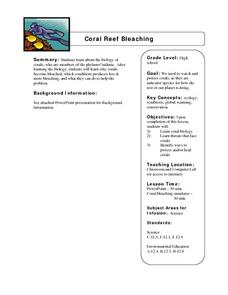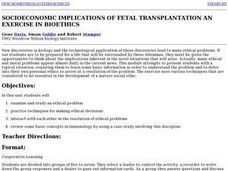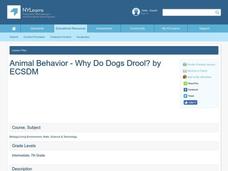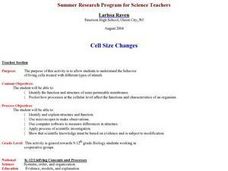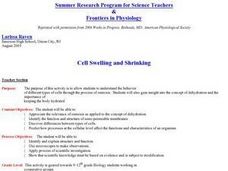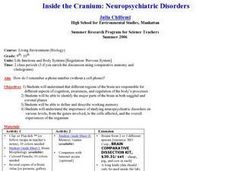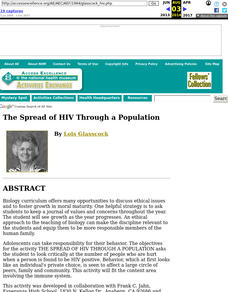Curated OER
Superhumans and Bionics: Building Hi-Tech Exoskeletons
Students explore how the body works. Students experiment and participate in activities to compare speed to stride length. Using the data collected, students draw conclusions about the biology of dinosaurs, their speed and stride length.
Curated OER
The Importance of Making Labs a Priority
The benefits of inquiry-based exploration can be attained in any classroom.
Curated OER
Coral Reef Bleaching
High schoolers explore the structural biology of corals. Working individually, students identify how corals become bleached and which conditions produce more and less coral bleaching. High schoolers explore how this effects the...
Curated OER
Genetic Research: A Congressional Hearing
Students participate in a mock hearing of the U.S. Senate subcommittee on genetic research. They representing support groups for various genetic disorders present arguments for continued federal funding, while subcommittee members are...
Curated OER
Socioeconomic Implications of Fetal Transplantation An Exercise in Bioethics
Students explore ethical problems. In groups, students examine and study a given ethical problem. They practice techniques for making ethical decisions and interact with each other in the resolution. Students support their decision...
Curated OER
The Siberian Arctic
Pupils, in groups, research the topics: habitats of northwestern Siberia, reindeer, oil and natural gas, and other threatened regions of the Arctic. They answer specific research questions based on their topic. They use online resources...
Curated OER
Migration
Students explore migration using the Internet and several pre-chosen websites. In this animal migration lesson students divide into groups and complete a lab activity.
Curated OER
Animal Behavior - Why Do Dogs Drool?
Seventh graders give examples of learned behaviors. In this life science lesson, 7th graders simulate a behavior conditioning experiment. They complete an assessment at the end of the lesson.
Curated OER
Animated Video Productions - Life Cycles
Seventh graders compare/contrast the life cycles of free-living organisms to that of parasites. They conduct Internet research, illustrate the stages of a specific organisms's life cycle, and direct and produce a mini-video production.
Curated OER
Cell Size Changes
Young scholars examine the behavior of living cells treated with different types of stimuli. They watch an online movie, examine wet mount slides under a microscope, take an online quiz, and analyze data.
Curated OER
How Do We Use Scientific Inquiry To Solve the World's Problems?
Ninth graders examine how a scientific investigation is performed. They read and discuss examples of various scientific experiments, design an experiment involving fast growing plants, and create graphs and charts to present their...
Curated OER
Job Hiring...Who's the best candidate?
Students, working in teams, assume they are the newly hired research director of a biotech firm interviewing the top two candidates for the position of research scientist. They evaluate the candidates and decide who should be hired based...
Curated OER
Deep Blue Sea
Elementary schoolers identify the ocean floor in a geological sense. They create a presentation that highlights the key features of the ocean floor. This terrific lesson plan has excellent streaming video segments embedded in it, and the...
Curated OER
Cell Swelling and Shrinking
Students examine the concept of osmosis in relation to dehydration. They identify the function and structure of semi-permable membranes. They predict how certain processes can affect the characteristics of an organism.
Curated OER
Learning the Structure and Function of DNA
Students read about Humane Genome Project, examine structure and function of DNA, and participate in gel-electrophoresis lab. They complete Internet activity to test their knowledge of DNA.
Curated OER
Inside the Cranium: Neuropsychiatric Disorders
Young scholars analyze different regions of the brain which are responsible for different aspects of cognition, awareness and regulating the body's process.
Curated OER
Bioethics
Students are introduced to the issues surrounding bioethics and begin to discover how some of these values can influence decision making. The exciting part of this lesson is the constructivist method used to engage students of all...
Curated OER
Elegant Embryology
Students observe embryogenesis in action through early stages of development of eggs. They observe cultures with dissecting and compound microscopes. They draw their egg, record any details and observe for changes. They compare their...
Curated OER
Neural Pictionary
Students explore the nervous system. They pictorially illustrate terms that deal with the nervous system. Students play a "pictionary" game to review nervous system vocabulary words.
Curated OER
What Does My Bacteria Look Like?
Pupils identify Gram positive and Gram negative bacteria using staining techniques. Students research importance of identification of bacterial types in diagnosing bacterial diseases.
Curated OER
The Talk Show: A Bioethical Dilemma About Neurological Disorders
Students explore neurological societal problems. They research, collect information and assess the ramifications of ethical, economic, political, and social issues. During a talk show simulation, students present their decisions.
Curated OER
How Many Bacteria on Your Food?
Students discuss and conduct a food safety experiment which looks at bacteria and food poisoning. They swab the other area of some food and grow bacteria in an agar plate.
Curated OER
The Spread of HIV Through a Population
Students use a model to illustrate the spread of HIV through an adolescent population and, acting in the role of epidemiologists, explore the dilemmas of HIV infection presented by the simulation. beneficence and justice.
Curated OER
Huntington's Disease
Students research specific genetic disorders and create a pedigree of a fictitious local family in which Huntington's Disease is found. They predict inheritance and severity of HD and role play decision making process involving genetic...




